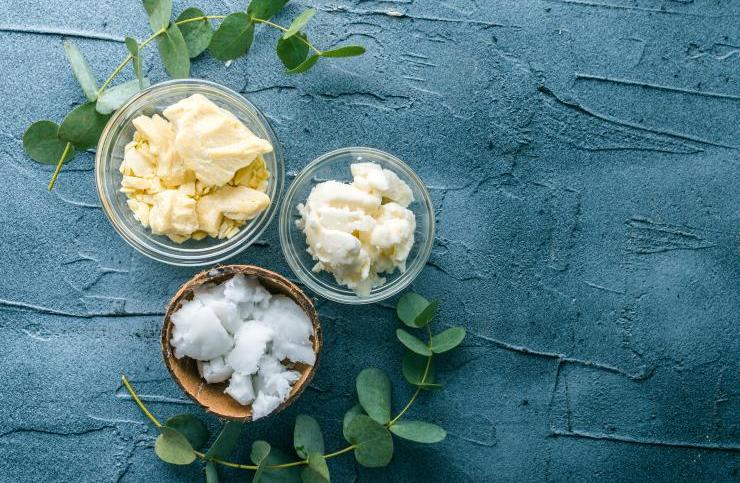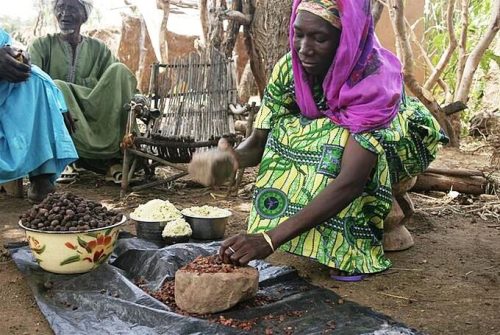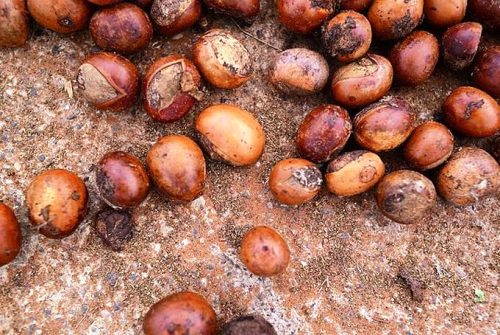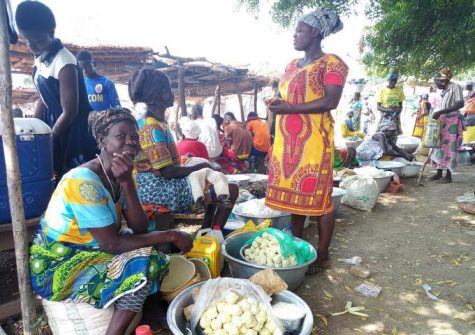The Long Journey of Shea Butter.

From the savannahs of Africa to the global cosmetics industry, we reveal the secrets of a prodigious butter. Shea dominates advertisements and the labels of body care creams, but its uses in Africa are multiple, not only linked to cosmetics. We went to Ghana to see how this surprising butter is created, a product that generates jobs for women and helps protect the environment.
A group of colourfully dressed women are sitting on bright mats arranged around a tree. Each one has at her side a large aluminium container full of a thick dark brown mush that she mixes with gestures that seem to recall ancient rituals. The Slender arms of young girls in their early teens and the wrinkled wrists of elderly women move in unison, almost caressing the brown molasses with circular gestures and then giving it a sudden blow, very like a slap that makes the entire contents of the tub tremble. It’s hard to believe, but that fluid with the colour and consistency of mud will become, after a long refining process, a highly sought-after white opaline substance now widespread throughout the world: shea butter.
We are in Nyankpala, a village on the road that connects Tolon to Tamale, in northern Ghana, one of the regions where the production of karité or shea butter, is most widespread. As often happens, it is the name of the product that best explains its origins: it is believed that the English word shea derives from the Bambara term shìs, while in the Wolof language, the nuts and their butter are called kharitì, from which comes the French karité.

A woman processes Shea tree nuts into Shea butter. CC BY-SA 2.0/ Treeaid
The so-called Shea Belt, the territory of shea butter, occurs in fact in the savannah areas south of the Sahara, from the hinterland of Senegal to the north of Cameroon, with peaks in Central Africa and Chad, but the bulk of production is concentrated between Mali, Burkina Faso, Ghana, and Nigeria.For at least ten years, shea has dominated advertising and the labels of creams and body care products, but it has many uses in these areas that are not necessarily linked to the production of cosmetics: butter is used to make candles, medicines and soaps, but it is used primarily as food. It is an excellent fat for frying and is both economical and nutritious; the flavour that shea imparts to dishes is unmistakable, strong and at times earthy, halfway between that of hazelnuts and roots, so much so that it has become a distinctive feature of the traditional cuisine of many Sahelian regions.
From fruit to butter
This versatile and highly sought-after product originates as a small fruit, similar to a green plum, which grows on tall trees with thin, oblong leaves. However, the sweet and tasty pulp hides a much greater treasure: a smooth stone with the appearance of a chestnut, which through long processing and refining processes will transform into the well-known butter.In these areas of Ghana, domestic production is practised by almost all families in the rainy season, when the green fruits ripen, but, since butter is the cheapest and most appreciated element for frying, demand is high throughout the year.

Shea Butter seeds are used for preparing oil. CC BY-SA 4.0/ Amuzujoe
For this reason, artisanal wholesalers or professional producers accumulate large quantities of stones to be able to make and sell the product even in the dry season.
Initially, the process begins with boiling, followed by breaking the shell, the so-called crushing, which in the villages still happens manually, in wooden mortars struck rhythmically with long poles; the nuts are then roasted for the first time and again ground. This is but the beginning of a still long process that continues with the meticulous mixing phases, an ancient art that takes place in groups, in courtyards, or under a tree, and which enables the production of a preparation that is perfectly fluid and easily refined. The last step is the long boiling of the raw butter and its refinement, gradually removing the light parts that come to the surface to obtain a product with its characteristic amber-white colour.
The challenges of the economy and the climate
At Tamale market, shea butter is sold in small, coloured pots from which it flows out in tall white cones that resemble the spires of traditional mosques made of plastered mud. A customer lets out a cry of surprise when she hears the price. Inflation and the increase in the cost of living are hitting hard here too, but the challenges are many: the ever-increasing demand for butter for the cosmetics industry in the Western world has caused a significant increase in prices but also a distortion of traditional production and sales networks.
In such a delicate context, urbanization also becomes a challenge: Tamale and the other medium-small towns are growing at frightening rates, much higher than the regional average. Although shea trees are protected by law, they are increasingly being cut down to make way for houses and roads or even for firewood.

Women selling shea butter in Ghana. CC BY-SA 4.0/ Dominic A. Kyilleh
A significant environmental problem: these plants which require little water, survive drought, and do not require fertilisers, are fundamental for ensuring an ecosystem balance in savannah areas; not to mention that a shea tree can take up to twenty years to bear new fruit, a very long time that does not allow this heritage to be affected. A further demonstration of how traditional productions, social networks and environmental protection go hand in hand and are all parts of a single precious mosaic that must be preserved.
The sun, still high in the sky, filters through the leaves and enhances the bright colours of the mats; the laughter and voices of the women overlap the rhythmic sounds of hands as they stir the butter: the long journey of the shea butter is just beginning, but it is already rich in colours, sounds and timeless traditions. (Open Photo: Shea Butter. Shutterstock/Maramorosz)
Federico Monica/Africa



